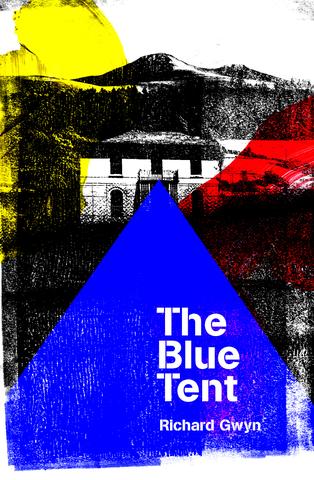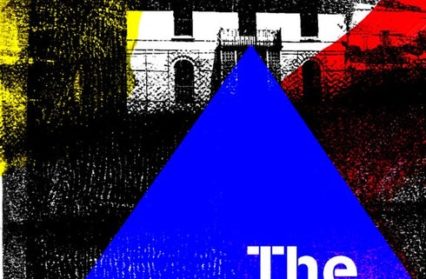Harper Dafforn delves into the dream-like world of The Blue Tent, the latest novel from the award-winning author, Richard Gwyn.
From an early age, writers are warned against committing the heinous crime of ending a piece of work with the revelation that the protagonist has woken up and “it was all a dream.” The Blue Tent, hispanist Richard Gwyn’s contribution to the magic realism genre, appears to play this trick; but in gradually constructing a complex nightmare-world from which the only logical escape must be a return to unaltered consciousness, Gwyn more than gets away with it. The novel’s chief tension hinges on the narrator’s slowness in coming to this conclusion himself, so immersed is he in an experience of his own making.

True to the fabulist tradition, a scenario which is introduced at the beginning of the novel as hyper-realistic is rapidly invaded by, and becomes a breeding ground for, the incredible; following the death of his enigmatic Aunt Megan, the nameless protagonist has returned after a decade abroad in Mexico to his native Breconshire to pursue a hermetic existence pouring over the collection of books bequeathed to him by the deceased, in her isolated manor in the Black Mountains.
That Megan was a collaborator of C.G. Jung, having set up a cryptic trail of instructions as to the sequence in which the books in her collection should be read, and apparently having left a forest of weed growing in the garden shed, acquires a meta-fictional significance as the plot progresses. Indeed, as the occupants of the blue tent emerge and offer vignettes into Megan’s life, her shadow looms over the events as their apparent mastermind, perhaps the engineer of a self-perpetuating posthumous experiment which traps a living participant with “drifting or devious spirits” in a hologram of the past, in the vein of the recorded reality in Adolfo Bioy Casares’ classic novella, La invención de Morel.
It transpires, however, that the explanation as to what exactly is going on in The Blue Tent is rather more evasive. The immediacy of the present-tense narrative denies the protagonist the opportunity to reflect on his experience, even though it is implied at several junctions that he is recording the absurd episode only after it has occurred, as if in a frantic attempt to preserve a dream before it “shift[s] its contours and belong[s] to someone else.” As a result, the more outlandish elements of his situation are accepted by him more readily then they are by the objective reader. Although it does not strike him as utterly banal that after investigating the strange blue tent in his backyard for the first time, Alice, a “sweet gypsy girl” should fall into his lap – or rather, stride into his kitchen and offer to make him tea – he resigns himself to their immediate passage into domestic companionship and begins to concern himself less with the nature of her arrival than with the nebulous quality of their relationship.
As more characters emerge, triggered, apparently, by his entry into the tent, the status quo established between the initial housemates is undermined; these new tenants have protean personalities, their appearances, behaviours and even their ages seeming to shift according to the protagonist’s private concerns. Likewise, his own narrative voice contributes to our sense of shifting ground, as rather than discussing the literature he has pored over for so long, he seems to have internalised its archaic style as a new way of relating to the world; Victorian syntax and descriptive habits mingle with modern argot (“bullshit”, “ganja”) in an often comic but otherwise unnervingly anachronistic style, so much so that the eventual disclosure of his young age comes as a shock.
As suggested by the inclusion of one of its extracts in The Blue Tent’s quartet of epigraphs, J.L. Borges’ short story El Aleph is more than an influence on Gwyn; his novel offers a kind of sequel for the eponymous enchanted object, “a small and miraculous cavity or portal that displays the entire substance of the universe, and all possible worlds.” If, however, the role of the object is ambivalent in its original narrative, it is even less precise in this one. After O’Hallaran, a central character, recounts his exchanging the Aleph for Megan’s blue tent, the “silver cylinder” is promptly forgotten about until the closing pages of the novel, whereat it is revealed as the culprit for “disgorging” the protagonist’s visitors from another world.
However, this conclusion is not elaborated upon and is immediately succeeded by his scheme to quit the metaphysical trap. As the man awakes with an object which he alleges to be the Aleph in his hand, the question of what degree of credibility we should attribute to his account is left unresolved: I was left reeling wondering if I had just read about an insomniac’s hallucination, the product of losing himself in a labyrinth of footnotes as intimated by the epigraph from W.G. Sebald’s Austerlitz; whether, considering the hints at a sleeplessness-induced psychosis subtly imbued into the fabric of the novel were merely incidental or intended, like the clues present throughout Chuck Palahniuk’s Fight Club, to nullify a lonely man’s fantasy. The Blue Tent continues to frustrate and ensnare long after it is set down, its haze of possibilities proving for compulsive re-reading.
The Blue Tent by Richard Gwyn is available now from Parthian.
Harper Dafforn is a Cultures Editor at The Flete.











